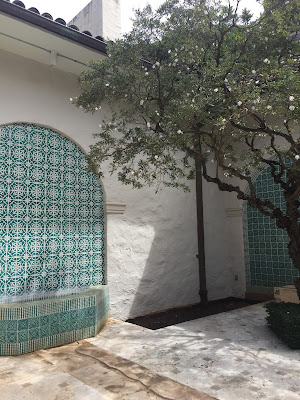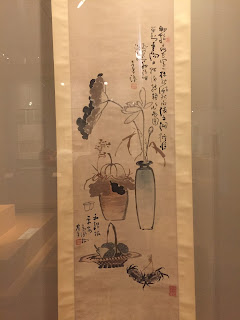Making Lei & Gallery Walks
Hey everyone!
This past week I was able to do some new things both on, and off, campus.
First, as the title implies, I was able to make my very own flower lei. The process goes like this:
1. start by taking a long needle and slipping thread under the side with the loop. The needle I used was just barely closed, meaning it was wide enough to slip the thread under the loop
2. Taking the sharp end of the needle, pierce through the flower and run it through the string
3. Continue this step until you have the desired amount of flowers on the string. If you're aiming for a crown, anywhere from 35-40 flowers will suffice. If you're looking for a more "traditional" look, then 40+ flowers will do well.
I had one of the girls take pictures of the process so you guys can visually see how they're made!
The flowers are a beautiful purple and white, and apparently pretty cheap. They're orchids, and probably one of the most common flowers used to make lei. The other kind you could make was a tea leaf, but I wasn't as interested in those.
Fast forward to yesterday, where I finally made my way to the Honolulu Museum of Art.
On the outside the museum is very plain look. In fact, I would even say it doesn't look like a museum. However, upon entering you immediately know that you are someplace special. The entrance is met with an outside courtyard and Greek statue. When you walk right you are met with an absolutely beautiful Mediterranean courtyard that has a flowering tree and a fountain. On the walls are a beautiful teal print, and along the sides are metal seats to relax on.
When you proceed to the first exhibit, which is on the door to your right just outside the courtyard, you are greeted with a deep purple room that houses a gallery of impressive, and classical, types of paintings.
The flower one was one of the more impressive paintings in the room, but so was the renaissance painting of the group of children (which I didn't take a picture of). The room was quite large, and these were only two of about a dozen.
The room then leads into a gold room that is home to dozens of Christian paintings. These were beautiful as well, and I didn't take as many pictures as I probably should have. Here are a few:
Continuing into the next room, you are immediately taken into a gallery with walls a deep blue. This time period was obviously very feminine with inspiration drawn from the Greek. There were quite a few statues in this room, and some, like the statue of Venus, didn't have a head. I only took one picture, and it was of a floor-to-ceiling length rug that seemed to depict various animals.
Once we left the room we proceeded to the next few exhibits, which could be found a little ways outside.
From here I would like to point out that many, not all, of the paintings had two descriptions, one in English and one in Japanese.
Then we walked into one of the larger rooms that proudly displayed one of the Water Lillies.
 |
| A young woman sat beneath the painting making her own version with chalk |
The exhibit had about half a dozen paintings, many of which were from the Victorian-era, or at least appeared that way. My favorite, though, had to be the famous "Water Lily" painting by Claude Monet. Yes, it was an actual Monet, right in front of me and on display!
the outside area, where this time we were met with a restaurant and a staircase leading to somewhere else. Upon entering, it because clear that this exhibit, judging from the title "Art in Hawaii" would feature some local artists. The art varied from pictures to clothing, and in the very back there was even a room with multiple Chinese figurines that talked about Mao Zedong and the cultural differences between the East and the West.
After this we went to the next exhibit, which was a stunning collection of art from China, Japan, and Korea. China had by far the most work, but Japan came in a close second. Here are some pictures:
 |
| A beautiful painted Chinese fan |
 |
| The detail on the long scrolls is incredible |
 |
| The detail on the cups is also worth mentioning |
 |
| Qing Dynasty furniture |
And now onto some photos from Japan
The next few are some pictures about Japanese tea and their respective ceremonies!
And again, a Japanese tea house. Remember a few posts ago where I went to the Japanese garden on campus? This is what the house looks like there, so it was really cool seeing similar ones from pictures in Japan.
After this section we continued walking and made our way to the floor that was home to various art based on location. Seriously, this museum is amazing.
The art in the beginning is American and quite old. The paintings range from landscape drawings to what America used to look like, to portraits of American children. Here are a few:
This painting is a very incredible one, too, because the description to the right even claims that the beauty was something that "Art itself could not even capture". To me, when the artist themselves admit that the beauty was something impossible to recreate, than it must be something truly magical. If I remember correctly this actual landmark can be found in Wyoming, but I doubt it looks the same today.
Paintings like this are simply astounding. It's a place that looks serene, and cut off entirely from the outside world. From where the painter is sitting it also appears that they are deep into the cave, so the artist would have had to go through a lot to capture this moment. It's something that very few have, I'm assuming, been able to accomplish, but a sight I'm sure they've all appreciated. From the inside, the outside gives the feeling of wilderness, of something untouched by people. It's interesting to think about what could be beyond those cave walls.
The painting on the left, in the circular frame, was probably my favorite out of the entire floor. I really loved the detail the artist had, and how meticulous he was in capturing the proper scenery. You can't tell, but in-between the trees was a tiny flock of geese flying away. I felt the most from this painting, too, because it's something that can absolutely never be recreated. It's a time in America that can't be touched, and it's a time no one alive today has ever lived through. I think this really captured the American spirit, because it's just a group of people and their dog, going out into the unknown, with nothing in sight. It's amazing how there's no high-rises or skyscrapers, no Walmart's or houses, just wood. It's something I wish I was able to see in person. To the right of it in the description.
Below are some pictures taken of the Native American, African, and Filipino exhibit. The Native American one was perhaps the smallest, and it was interesting to see how the location was unknown for many. The labels had guesses as to where these pieces came from, but it's crazy to me that the collectors just didn't know.
 |
| A wall of saints in the Filipino exhibit |
The last of the exhibits had a sign on the wall, which is what I believe ends this post perfectly. It's something I stood at for a while, reading it and taking in it's message. I hope it has as much of an impact as it did me, on you. As always, have a good rest of your week and I will talk to you all soon.
Aislinn



















































0 comments